Narayan Sharma
Other projects
22 Dec 2014
The Impact of Harvest of a Critically Endangered Dipterocarp Vatica lanceaefolia on its Population and Regeneration in the Rainforests of Northeastern India
The project aims to understand the behavioural mechanisms that facilitate the coexistence of seven primate species in the fragmented habitat of Gibbon Wildlife Sanctuary, Assam, India.

The transformation of extensive tracts of rainforests in the Upper Brahmaputra Valley into smaller, isolated fragments has seriously threatened the region’s wildlife. Given that these fragments continue to harbour endemic and threatened species, it is crucial to understand factors that allow them to survive in these habitats, and to design conservation strategies based on such understanding.
Our recent survey for six diurnal primates across 32 fragments of the Upper Brahmaputra Valley revealed that over two-thirds of the fragments had lost one or more primates species over the last 30 years. In particular, the stump-tailed macaque (Macaca arctoides), pig-tailed macaque (Macaca leonina) and Assamese macaques (Macaca assamensis) showed the greatest declines. Remarkably, however, in the Gibbon Wildlife Sanctuary, a fragment of around 2,000 ha, we found healthy, breeding populations of the region’s entire complement of seven primate species (Macaca arctoides, Macaca leonina, Macaca assamensis, Macaca mulatta, Trachypithecus pileatus, Hoolock hoolock and Nycticebus bengalensis). This fragment thus offers a unique opportunity to understand the anthropogenic regimes as well as the ecological and behavioural mechanisms that have enabled the persistence and coexistence of this rich primate assemblage in a regional context characterized by widespread local extinctions.
Our proposed work will help understand the suite of ecological and factors that have enabled the survival of all seven species in Gibbon WLS. This, in turn, would help in the management and restoration of other fragmented primate habitats of the region. It is remarkable that seven primate species in Gibbon Wildlife Sanctuary fragment coexist in apparent harmony with each other, while maintaining healthy breeding populations. Understanding the ecological and behavioural mechanisms that have allowed closely-related species, particularly the macaques, to flourish in sympatry in this benchmark site would help assess the scope and limits to restoring primate assemblages in forest fragments of the Upper Brahmaputra Valley.